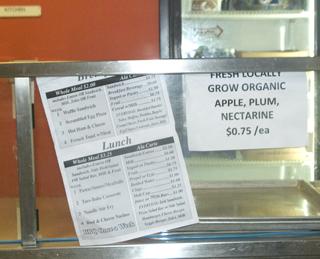
Healthy organic fruits are now being advertised along side the regular menu in the cafeteria. Photo by Deepa Kollipara.
FUHSD now trying to sell organic healthy food in the lunch line.
The district is going green, eating-wise that is.
Cupertino has the second largest Whole Foods store in the nation, and a newly opened Trader Joe’s on Bollinger Road. With the city’s organic trend in full force, it is only inevitable that schools follow suit. Last month, FUHSD Nutrition Manager Bill Schuster and his supervisory team made the choice to go organic, making another great leap in the school lunch system.
Organic at FUHSD carries the same meaning as it does at the produce section of Whole Foods: locally grown, fresh, and pesticide free.
Organic at FUHSD carries the same meaning as it does at the produce section of Whole Foods: locally grown, fresh, and pesticide free.
Previously, fruits, such as oranges, were purchased from other states, like Florida, and placed in storage bins to help preserve them for months.The district plans to buy fresh grown fruits in Fresno Valley, plucked only a week before they are seen next to a student’s pizza and juice.The FUHSD nutrition department will also check to ensure lunch line fruits are pesticide free.
The healthy fruits made their debut at the lunch line last month, starting with organic apples, and slowly expanded to include plums and nectarines.
The healthy fruits made their debut at the lunch line last month, starting with organic apples, and slowly expanded to include plums and nectarines.
The organic trend isn’t unique to FUHSD. According to the U.S. Department of Agriculture website, estimated 10,800 schools in 34 states have farm-to-school programs. However, MVHS continues to provide regular fruits to students due to a USDA regulation, which currently prohibits schools from having geographic preferences when buying food. Another obstacle local growers face, compared to mass grown wholesalers, is meeting stringent food safety standards that can only be done with money that small local growers don’t have. For farmers, costs range from buying advanced non-pesticide pathogen killers to buying sanitary storage and transport bins for a grower’s fruits.
There are down sides to organic fruit. Just as Safeway’s burritos are $1.14 less than Whole Foods’ organic ones, non-organic fruits cost $0.25 less than organic fruits. However, most students pay for organic fruits as part their $3.75 normal lunch meal, which absorbs the extra cost of organic fruit. In other words, an entire lunch meal is always $3.75 with or without organic fruit.
To a la carte worker Barbara Prince, going organic was the next logical step after adjusting FUHSD school meals last year to fit the new state standards.
“Its hard for the kids to switch over to totally healthy because they’re used to having junk food. But that’s turning over. Kids are starting to realize that eating healthy is an important item,” Prince said.
However, some students are doubting whether or not organic fruits will make a difference on teen eating habits.
“[Organic foods] will only make an impact if there’s no other alternative. People eat unhealthily out of convenience because cheap and tasty junk food is always available,” junior Brian Egan said.








